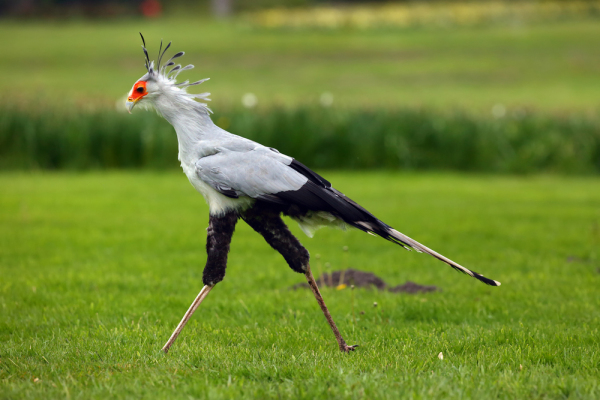
The Secretarybird or Secretary Bird(Sagittarius serpentarius) is a terrestrial bird of prey that can be found in savannah habitats throughout much of Africa. The Secretarybird gets its name from its elongated head plumes, which resemble writing quills.
Physical Characteristics
Adult Secretarybirds have long pink legs, long black crest feathers, bare orange faces, hooked bills and long central tail feathers. They are gray above, and white below with black flight feathers, abdomen, and thighs.
Juveniles are similar to adults, but have shorter tails and crests, with grey barring on white underwing-coverts and undertail-coverts. Juveniles also have paler faces.
| Length | 1.1-1.5 m(3’7.3”-4’11.1”) |
| Wingspan | 1.9-2.2 m(6’2.8”-7’2.6”) |
| Weight | 2.3-4.3 kg(5.1-9.5 lbs.) |
*Subspecies
The Secretarybird is currently classified as a monotypic species, this means that there are no subspecies classified under Sagittarius serpentarius. Subspecies are populations that show subtle differences from other populations. Subspecies are usually reserved to certain geographic areas.
Range
The Secretarybird lives in the African countries of; Angola, Benin, Botswana, Burkina Faso, Burundi, Cameroon, Central African Republic, Chad, The Democratic Republic of the Congo, Côte d’Ivoire, Djibouti, Eritrea, Eswatini, Ethiopia, Gambia, Ghana, Kenya, Lesotho, Malawi, Mali, Mauritania, Mozambique, Namibia, Niger, Nigeria, Senegal, Somalia, South Africa, South Sudan, Sudan, the United Republic of Tanzania, Togo, Uganda, Zambia, and Zimbabwe.
Habitat
The Secretarybird inhabits savannahs, forests, and sub-desert areas.
Breeding
Secretarybirds are monogamous(mate for life); They can breed at any time of the year, but more frequently in the late dry season. The Secretarybird’s nest is a large platform that is made of sticks, and placed on the top of a tree. The nest is lined with grass, wool, and mammal dung. The female lays a clutch of 1 to 3 eggs. The eggs are white with very sparse dark markings. Both the male and female incubate the eggs for 42 to 46 days. When the chicks need nourishment the parents will regurgitate food; the parents regurgitate water for their chicks as well. The offspring remain dependent on their parents from 2 to 3.5 months.
Diet
The Secretarybird eats insects, frogs, lizards, small tortoises, snakes (including venomous species), birds, small rodents, hedgehogs, mongooses, squirrels, hares, crabs, and eggs.
Conservation Status
The Secretarybird is listed as endangered.
*Definitions
Coverts. Coverts are any of the feathers covering the bases of the main flight or tail feathers.
Fun Facts
- The Secretarybird is nicknamed “Africa’s Marching Eagle”.
- The Secretarybird can cover 28.96 km(18 miles) on foot in a day.
- Secretarybirds have been known to place their nests on treetops as high as 36 meters(118 feet,1.3 inches) above the ground.
- The Secretarybird can live for up to 19 years.
- In the Disney movie “Bedknobs and Broomsticks”, one of the residents of Naboombu, the assistant to King Leonidas, is a Secretarybird.
- The Secretarybird often kills its prey by stomping it to death; this is the method it uses when killing poisonous snakes.
- The Secretarybird is illustrated on the Emblem of Sudan.
- The first successful rearing of a Secretarybird in captivity occurred in 1986 at the Oklahoma City Zoo.
